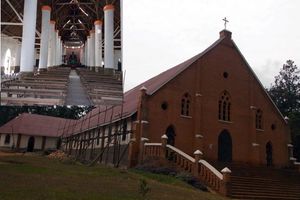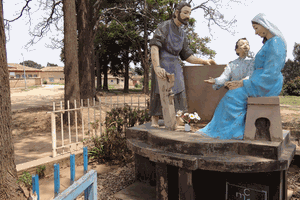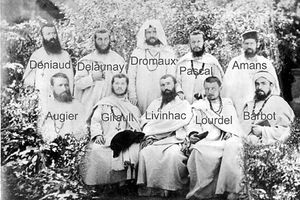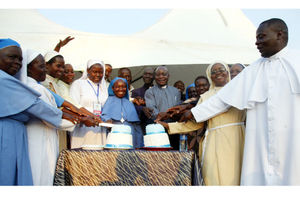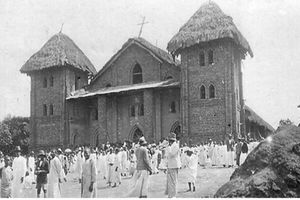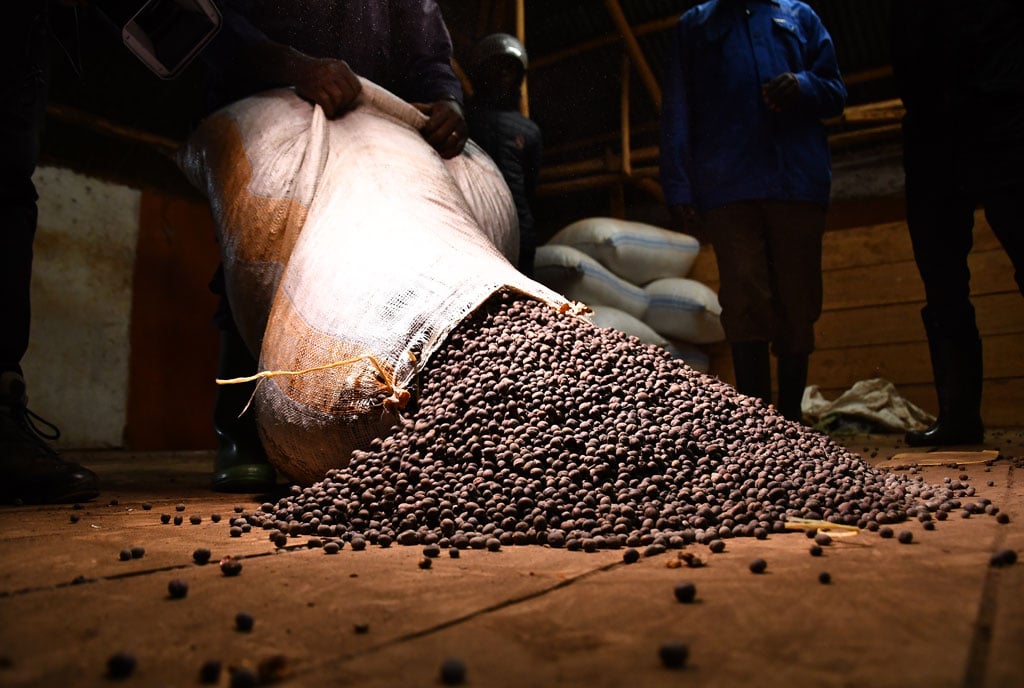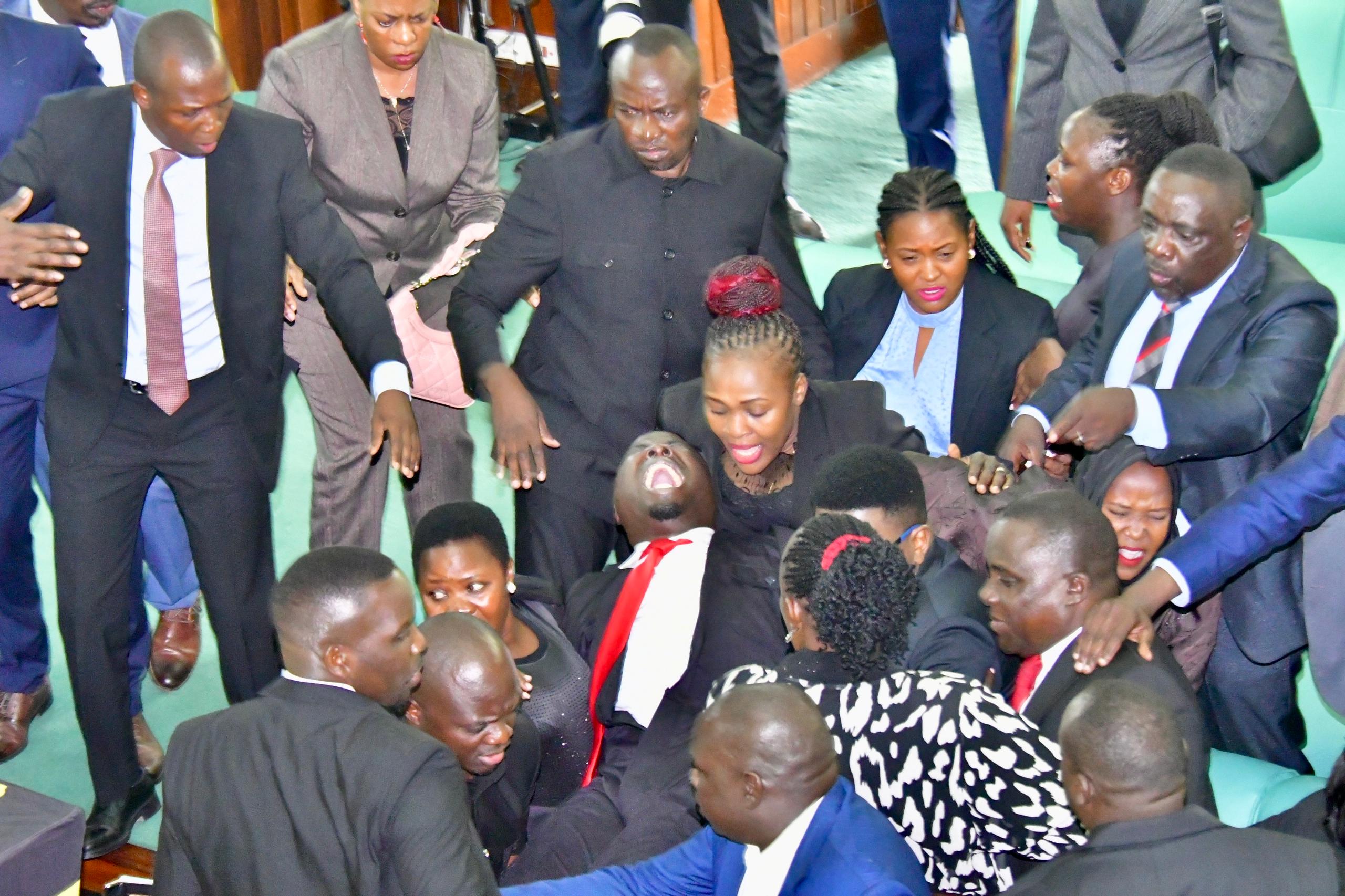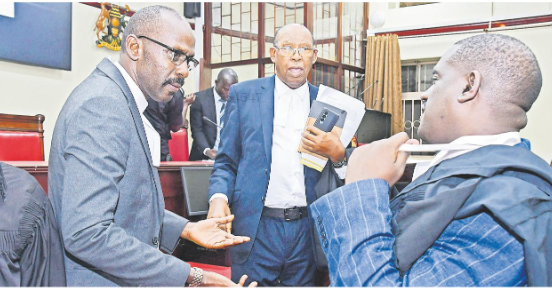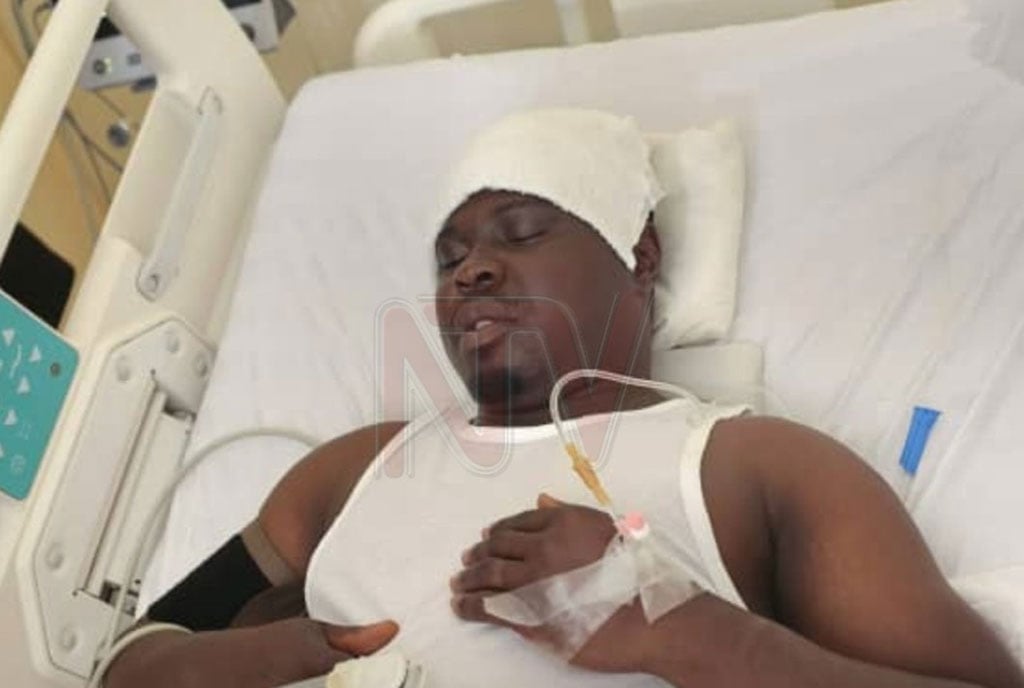
Rev Fr Vincent Lubega, the Namugongo Catholic Parish Priest (holding cross), welcomes Archbishop-designate of Gulu Archdiocese Raphael P’mony Wokorach (3rd right), Lira Diocese Bishop Sanctus Lino Wanok (2nd right), and pilgrims from Nebbi District to at the Uganda Martyrs’ Shrine Namugongo in Wakiso District yesterday. Nebbi Diocese is set to lead Martyrs’ Day celebrations on June 3. Photo | Herbert Kamoga
The seeds that the missionaries sowed in 1910 when they first set foot at Omach in Pakwach District continue to bear fruit as witnessed with the growth of the Catholic faith, introduced in Nebbi District by the Comboni missionaries.
A book by Fr Toni La Salandra, a Comboni missionary, says before the 1910 journey, there were arrangements by the missionaries in 1885 to spread the word of Christ in West Nile, beginning from Khartoum, Sudan where St Daniel Comboni was settled.
The missionaries had come from Italy to spread the word of God, offering hope to the sick, and poor, and ensuring peace prevails among families.
While at Omach Village mission in Pakwach, the missionaries suffered tsetse fly and mosquito bites and resultant illnesses. Despite these hardships, the missionaries pushed on with their work.
As they left Omach, they spread Christianity to Angal Parish in 1917, where they established a church and other institutions that helped to transform the lives of communities.
Today, the Nebbi Catholic Diocese is reaping from the work of the early missionaries.
Fr Salandra, a Comboni Missionary, who has traced the early Christian faith in Nebbi, writes in the book that the Catholic missionaries in West Nile faced hard times but never gave up.
He says whenever it rained, their grass-thatched houses, which acted as their shelter, would leak and let in rain as they spent sleepless nights.
The riverbanks, on the other hand, would attract mosquitoes that spread malaria.
First mission at Omach
Fr Salandra says in the book that more missionaries arrived from Italy and they included Fr Luigi Cordone, Fr Pasquale Crazzolara, Br Clement Schhroer, and Br Benedetto Sigle.
Fr Albino Colombaroli was appointed the first superior of the mission.
In 1912, the mission had to be rebuilt because it was makeshift and was then moved to another place, on a little hill sloping down to the Nile.
In the middle of 1912, Fr Colombaroli came back from Italy, accompanied by Fr Giuseppe Zambonardi and Br Luigi Savariano.
Second mission
In 1916, Fr Antonio Vignato, who was the superior of all the Comboni missionaries in Uganda, from Laropi in Moyo, left for Omach. In November 1916, he was informed that Bwana Gweno, the District Commissioner, had permitted him to cross the Nile.
Later, he moved to Angal and Orussi, where a mission was established. But the missionaries faced an outbreak of plague.
Third mission
In December 1917, the Angal mission was opened. Fr Audisio Pietro and Fr Domenico Spazian was the first priest to be appointed to it. Br Savariano from Moyo, via Arua, arrived at Angal to help build the Father’s house, a church and huts for Christians and schools.
On Christmas Day, 20 people, who came with the Fathers, were conferred the Holy Sacrament of baptism from Orussi.
From the baptismal register in 1918, Angal had 249 Christians, 70 catechumens in the mission, 18 catechists, six school chapels with 234 pupils, and 75 Christians in the mission.
After so many sufferings, some fruits sown in tears, were finally borne. But the joy turned soon into sorrow as smallpox killed many people.
After the departure of Fr Manfroni, Fr Lorenzo Bono was sent to Angal in 1975, with Msgr Paolo Jalcebo and Fr Dall’Amico.
Fourth mission
On December 9, 1932, the day following the solemn benediction and inauguration of the church of Angal, it was decided to divide the vast sub-district of the Alur with a new foundation of a mission on the mountains of Okoro.
Nyapea was chosen as a suitable place.
Institutions
The church has constructed several schools, like St Aloysius College Nyapea (STALCONY) in 1937, St Peter’s College Warr, Angal Senior Secondary School, Omach Primary School.
They also constructed health institutions like St Luke Angal Hospital, Holy Family Nyapea Hospital, Orussi Health Centre, and Agiermach Health Centre, among others.
Appreciating the fruits
On February 4, 2018, during the 100 years celebrations of Angal Parish, the former Papal Nuncio, Michael Augustine Blume, called for love, reconciliation and forgiveness among Christians to develop the church.
Blume said the Lord, who had sent out the missionaries and catechists, has never abandoned His people of Angal and there is a need to embrace the word of God and be faithful while expressing their joys in the biblical ways.
Former vice president Edward Ssekandi, urged the Christians in Nebbi Catholic Diocese to emulate the legacy of the Comboni missionaries to tap into promoting good governance.
Reactions from Christians
A parishioner of the Immaculate Heart of Mary, Nebbi Cathedral Parish, Mr Nestore Okorolal, said the Martyr’s Day celebration is very important because it restores and strengthens the faith and belief on which the believers based their trust.
“The long distance walk from Nebbi to Namugongo is the spiritual gift from God, which must be rewarded by greening the environment through tree planting,” Okorolal said.
Another parishioner, Ms Mary Akwiya, said the journey is a reflection of faith and Christians must take it as the learning point and repent their sins to earn spiritual rewards.
“We have benefited a lot from the Catholic faith that was brought by missionaries. Our children have studied in those schools and we received treatment from the health centres or hospitals built by them. The fruits of their toiling are visible and tangible up to now and years to come,” she said.
Mr George Okethwengu, a parishioner, said: “It is time for the corrupt leaders to come out and repent in front of Ugandans since the long distance is a sign of restoring peace and development, which is taken over by the corrupt leaders due to lack of trust and faith in God,” he said.
Current projects
Current projects include the construction of houses for the catechists of Nebbi Cathedral Parish, establishment of farms, leasing of land, construction of a parish hall, and more chapels and zones in the various parts of the diocese.
Msgr Jackson Osiga, the Parish Priest of Nebbi Cathedral, said: “Many of our catechists do not have better housing. They stay in their own homes. So, by building houses for them within the parish, they will stay near the church.”
Archbishop-designate Wokorach
Archbishop-designate Raphael Wokorach said the core of the message is the faith, which keeps believers united in Christ.
“The youth will hold the walk of faith in the areas of the martyrs. The martyrs help us to understand their lives and virtues.
“The people of Nebbi are receptive to faith and it is my dream that we have shepherds who can lead them. They are always there in the churches and do not get tired or hungry when in church; it is amazing,” he said.
“Our schools and churches are exploding because of the growth of population, and naturally, most communities are now starting to build their own churches. They make the bricks and start the foundation and raise the walls. Usually, it is the roofing that is a problem, and this is when they run to the bishop to help them,” he added.
He said there was a need to cement the work of the missionaries through the growth of faith with strengthening of the various institutions like health centres and schools. In order to salvage the problems of funding, the diocese has started the fundraising called, ‘With one heart’, where funding is put in a pool. Every Christian (of the 500,000) is expected to contribute about Shs5,000 every year.
These funds would then be used to buy materials for constructions of churches and schools, and the parishes, which have land, are advised to utilise them for agriculture to generate income.
A laity in Orussi Parish, Ms Grace Acamfua, said: “We have benefitted from the works of missionaries through the health centres, vocational schools and secondary schools built by missionaries. Even Muslims have continued to benefit from those. We have an obligation to keep the legacies left by the missionaries.”
How Nebbi became a diocese
Nebbi was part of the Gulu Apostolic Vicariate, established in 1923. So, Nebbi was established as a parish on May 18, 1963, under Arua Diocese, which was a vast territory for management by Bishop Angelo Tarantino (RIP) and Bishop Fredrick Drandua (RIP).
Consequently, the 28 year-old diocese was declared a Catholic diocese under the patronage of Immaculate Heart of Mary by Pope John Paul II on February 23, 1996, with her first bishop being John Baptist Odama until 1999.
After, Odama was elevated to become Archbishop of Gulu Ecclesiastical Province, Bishop Emeritus Martin Luluga (RIP) replaced him in 1999.
Later, His Holiness Pope Benedict XVI appointed the Rt Rev Sanctus Lino Wanok on February 8, 2011, till 2019 when Bishop Lino was transferred to Lira Diocese to date.
Later, the College of Consultors of Nebbi Catholic Diocese on February 11, 2019, elected the Rev Fr Emmanuel Odaga as the diocesan administrator to carry on temporarily the governance of Nebbi Catholic Diocese during the period of Sede Vacante until August 14, 2021 when he handed over the diocese to the new bishop, the Rt Rev Wokorach.
On March 22, Pope Francis appointed Bishop Wokorach as the new Archbishop of Gulu Ecclesiastical Province, replacing His Grace John Baptist Odama, who had reached the mandatory retirement age of 75.
This year will mark 60 years of the canonisation of the Uganda Martyrs. His Grace Wokorach will be the main celebrant on June 3.
GROWTH OF CATHOLIC FAITH IN NEBBI
• Number of Catholics: 549,118 in 2021
• Out of this about 51,888 are from Nebbi Cathedral Parish
• Parishes: 20
• Diocesan Priests: 69
• Religious sisters: 63
• Catechists: 997
• Size of the diocese: 5,098 sq km
Source: Nebbi Catholic diocese as at 2021
Trend of population growth of the Catholic faith
Based on a document by Acta Apostolicae Sedis, in 1999, there were 324,700 Catholics in the diocese. In 2000, there were 339,711, in 2001, the number rose to 353,000, in 2002, about 367, 298, in 2003, there were 383,481 and in 2004, there were 403,104 Catholics.
And from 2013, there were 510,080 Catholic, in 2016 there were 577,340, in 2019, there were 528,178 and in 2021, there were 549,118.
What they say...
Nestore Okorolal, parishioner.
The long distance walk from Nebbi to Namugongo is the spiritual gift from God, which must be rewarded by greening the environment through tree planting.
Mary Akwiya, parishioner.
We have benefited a lot from the Catholic faith that was brought by missionaries. Our children have studied in those schools and we received treatment from the health centres or hospitals built by them.
George Okethwengu, parishioner.
It is time for the corrupt leaders to come out and repent in front of Ugandans since the long distance is a sign of restoring peace and development, which is taken over by the corrupt leaders...
Msgr Jackson Osiga, Parish Priest of Nebbi Cathedral.
Many of our catechists do not have better housing. They stay in their own homes. So, by building houses for them within the parish, they will stay near the church.
